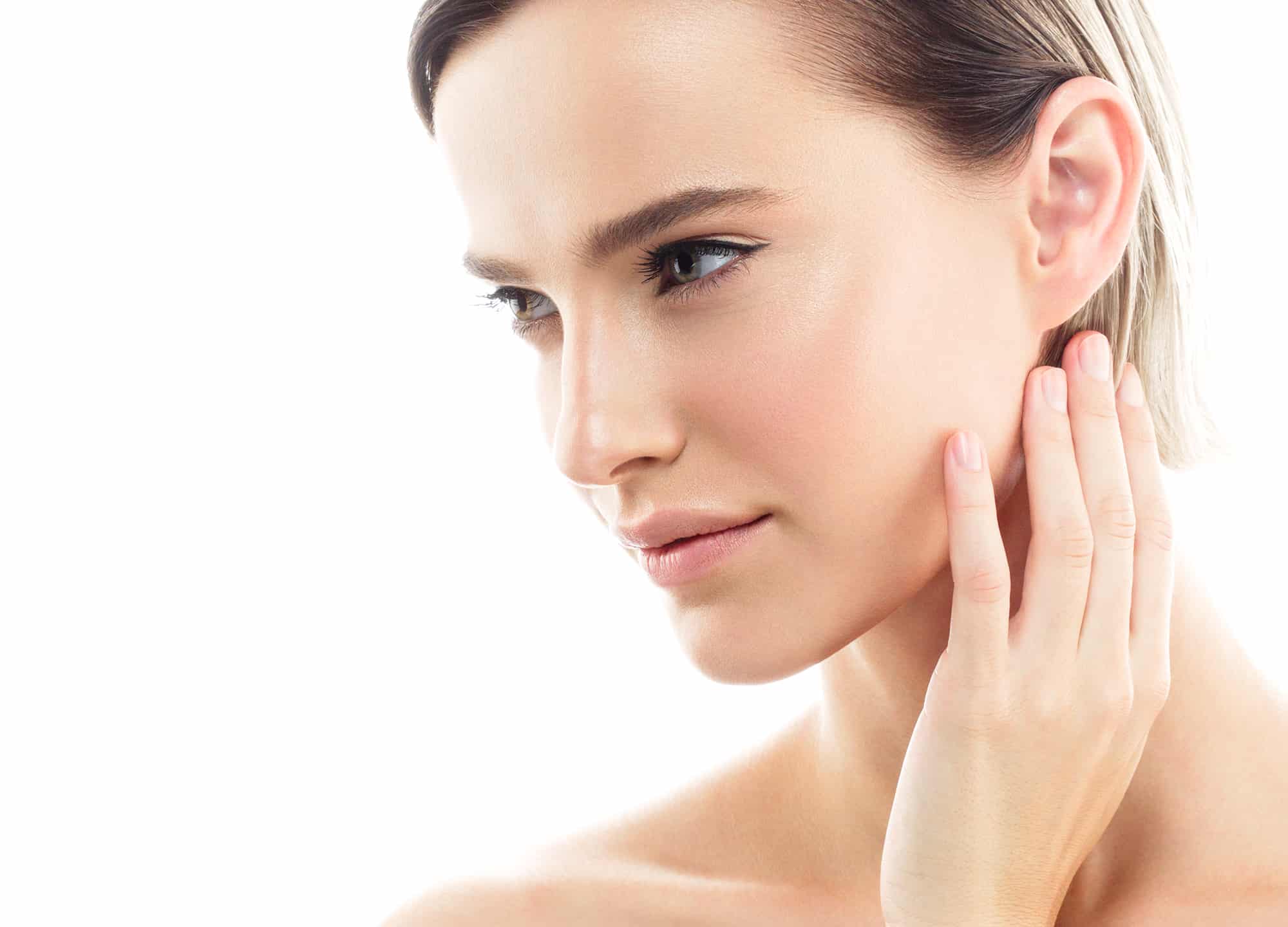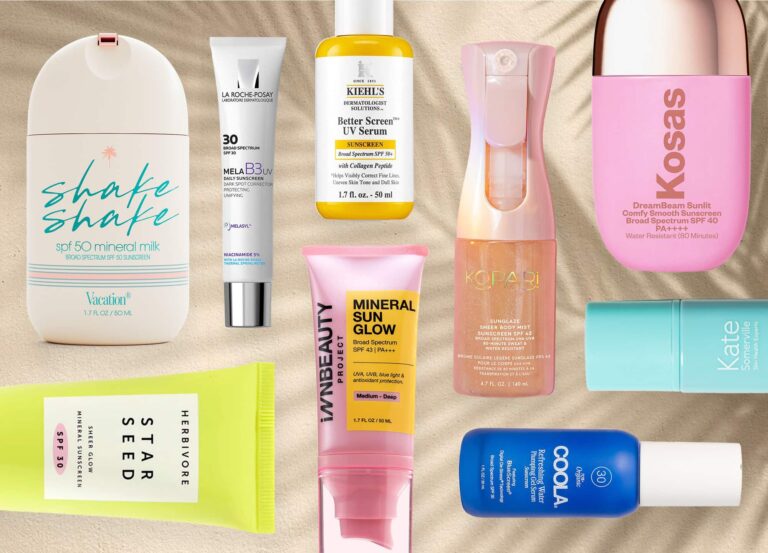A woman’s right to choose is a beautiful thing—unless, of course, it means choosing between beautiful things. Laser or IPL? Kybella or lipo? Radiesse or Restylane? Welcome to This/That, where each month, we’ll compare two common solutions to popular aesthetic concerns, delivering all the pros, cons, and caveats you need to make safe, smart decisions.
Forgive me, skin gods, for I have sinned. I have lain poolside, slicked with baby oil, in a Brenda Walsh–inspired bandeau bikini. I have succumbed to the warm glow of a pre-prom tanning bed (once, in 1994, but still). I have suffered blistering spring-break burns along the shores of Malibu and West Palm Beach.
While my DNA has, thus far, evaded malignant mutations (no skin cancer at last check!), sun-fueled brown spots, ruddiness, and fine lines have become my midlife cross to bear.
Melodramatic? Maybe a little, since such damnation is hardly eternal in our modern dermatologic age. There are lasers and light devices galore, tuned to target and expunge any evidence of youthful transgressions. The trick is knowing which options can best address your particular concerns—and how to sidestep complications and disappointment.
I’ve tried a number of lasers over the years, all with moderate success, and planned to keep on keeping on—until I noticed recently that intense pulsed light (IPL) was having a social media moment. My feeds were suddenly studded with vague but compelling before-and-afters and seemingly uncontrived praise from immaculate-skinned influencers and MDs.
And even with a career’s worth of skin reporting in my brain, I thought, Could I be missing out?
Figuring some of you might be wondering the same, I asked the experts to enlighten us on the differences between lasers and IPL devices, so we can choose our weapons wisely.
What distinguishes IPL from lasers?
Both lasers and IPL deliver light energy to various targets in the skin—namely, brown pigment, red hemoglobin, and water. The light, once converted to heat, vaporizes said bull’s-eyes to improve the appearance of sunspots, ruddiness, and discrete broken capillaries. When water molecules are pinpointed by resurfacing lasers, the heat creates micro injuries in the dermis to trigger repair and collagen synthesis, thickening the skin to smooth fine lines.
Despite sharing a common goal, the basic design of these two types of devices is fundamentally different—as is their attack strategy. A laser emits a single, precise wavelength of light to an intended target at a specific depth in the skin. It hits its mark with the accuracy of a sniper, avoiding collateral damage.
IPL sends forth a broad range of wavelengths—offering all the precision of a carpet bomb. Rather than honing in on a particular object, “the light is scattered about to diffuse targets,” says Dr. Robert Anolik, a board-certified cosmetic dermatologist in New York City.
Related: 5 Best In-Office Treatments to Try If You’re Not Ready for Fraxel
And this, according to our experts, is IPL’s main drawback—its lack of focus, which has earned it a reputation for being a sort of jack of all trades, master of none. It’s the classic downfall of the multitasker, is it not? “When you’re tending to multiple targets, you never really devote enough energy to any one thing,” says board-certified New York City dermatologic surgeon Dr. Paul Jarrod Frank.
Alluding to IPL’s haphazard style, board-certified Boston dermatologist Dr. Mitalee Christman calls the tech “laser’s messy cousin.” Its indiscriminate nature, she notes, renders it “dimmer and less powerful than a laser,” so it usually requires more treatments to achieve a similar fix.
Beyond its inherent weakness, IPL’s aimless energy disbursal can injure unintended targets. Of the myriad wavelengths it releases, “some are highly absorbed by epidermal melanin,” or the pigment in the skin’s topmost layer, “so it’s not safe for dark skin,” says Dr. Christman. “I’ve seen great results from IPL used correctly, but more often than that, I’ve seen branding—burns in the shape of the applicator—when it’s in the wrong hands.”
Since melanin resides not only in skin cells but hair follicles too, “you can’t go over hair-bearing areas with IPL—close to the hairline, near the eyebrows, or over the beard area in men— because the light can [inadvertently strike the pigment-rich bulbs within follicles and] remove the hair,” adds Dr. Frank.
On the flip side, however, it’s exactly this multifunctionality that appeals to certain dermatology practices and medspas looking for a single machine that can do it all—lighten brown spots; fade the redness of sun damage, rosacea, stretch marks, and scars; reduce hair growth; and spark new collagen—at least to some degree.
IPL’s shotgun approach can sometimes breed happy side effects for patients as well: “Whenever I’m treating rosacea, I’ll tell patients that some brown spots may fleck off too, as a by-product,” says board-certified New York City dermatologist Dr. Estee Williams.
Though dermatologic light devices are often discussed as if they were one generic nonlaser machine, it’s important to recognize that “not all IPLs are created equal,” says Dr. Nazanin Saedi, a board-certified dermatologic surgeon in Philadelphia. While lasers tend to have greater name recognition—Fraxel, Halo, Clear + Brilliant, PicoSure—IPLs also vary by brand, with some outpacing others in terms of safety and performance.
Related: 3 Pro-Strength Chemical Peels for Every Hyperpigmentation Problem
Many IPLs, for instance, “can be filtered in a way to limit certain categories of wavelengths,” says Dr. Anolik, allowing them to better concentrate their energy. Versatility takes other forms too. The Icon IPL by Cynosure “has two peak powers—one is more superficial, and the other focuses energy at deeper wavelengths—making the device more laser-like,” explains Dr. Saedi. The M22 IPL by Lumenis allows providers to “deliver the energy in one, two, or three pulses versus a single pulse only,” Dr. Williams says. “Having the ability to spread out the energy over several pulses means you’re getting the energy across but in a gentler way, because it’s parceled out.”
The Sciton BBL (broadband light) device, which is commonly paired with the Halo laser (from the same company), is another MD favorite.
Laser vs. IPL: Which is right for you?
When weighing IPL versus laser, consider your individual skin tone and concerns, your budget, and your tolerance for recovery.
IPL’s price point and lack of downtime boost its appeal among millennials, says Dr. Saedi. “The treatment course is easier and cheaper [than laser] and the downtime is less, so I use it mainly for younger patients”—those with faint speckling and/or redness who don’t yet need the serious textural correction and collagen-building prowess of a fractional laser and won’t accept looking red and flaky for days after treatment. (With IPL, skin is pink for mere hours post-zap.)
In the con column, IPL’s lack of control and extraneous energy output render it off-limits to those with deeper complexions and heat-sensitive skin. “I shudder to think of someone with melasma being treated with IPL,” says Dr. Christman. According to Dr. Saedi, IPL can sometimes make melasma look better initially—then the brown patches often return a few months later, even bolder than before.
For richly pigmented and melasma-prone patients, experts generally recommend gentle lasers with long wavelengths that let the practitioner control the amount of energy being delivered to the skin. The Clear + Brilliant Permea and picosecond lasers are good choices.
Some experts, like Dr. Williams, think it’s better to avoid light and lasers altogether in such cases, believing that “chemical peels are usually the best option for light- and heat-sensitive skin.”
While a laser’s sophisticated technology can make it more expensive, off the bat, than IPL, the cost of treatment can truly get prohibitive when lasers are stacked to tackle multiple concerns. Since there’s no single laser that can blanch redness, eviscerate sunspots, fade dappling, give a glow, and bump up collagen production—simultaneously addressing every item on the average fortysomething’s hit list—laser-savvy dermatologists will often use several pricey, high-powered lasers in tandem, to maximally upgrade tone and texture in one appointment.
The “standard of care for sun damage” is the Fraxel laser, says Dr. Frank; it treats the entire canvas of the face instead of select spots. (It’s also been proven to destroy precancerous cells.) “Although it’s primarily designed to build collagen, it has a secondary consequence of exfoliation, which releases the abnormal widespread pigment in the skin,” says Dr. Anolik.
If there are denser, darker islands of pigment amid the mottling, Q-switched and picosecond lasers can deliver focused blasts of energy to break them up. (In the Q category, Dr. Anolik typically reaches for his ruby laser for fairer skin and Nd:YAG for dark tones.) Dr. Saedi gets excellent sunspot clearance with her picosecond laser.
To quell background redness, pulsed dye lasers, like the Vbeam, are a gold-standard solution; KTP lasers, like the Excel V, are most effective for distinct red squiggles, notes Dr. Anolik.
In most cases, all these lasers can be safely combined. Treating skin of color with certain vascular lasers can be risky, however, since “some of the pigment in darker tones can compete with the vessels for the laser’s energy,” explains Dr. Anolik. “Settings need to be modified, based on reactions observed in the skin during treatment, and cooling tips and sprays can help minimize issues.”
The bottom line
IPL can remedy low-key mottling and redness at once, making it a solid prejuvenation tool for folks with minimal sun damage looking for a modest refresh. It’s safest for fair skin that can handle heat. Lasers are more potent and precise and offer greater control, making them suitable for nearly all skin tones and types—but they tend to come with a steeper price tag and more downtime. Different lasers can be layered, to attack multiple signs of damage in a single visit. Both lasers and IPL require several sessions for best results. And as a general rule, the person wielding the device, whatever it may be, holds far more sway over skin than does the tool itself.











